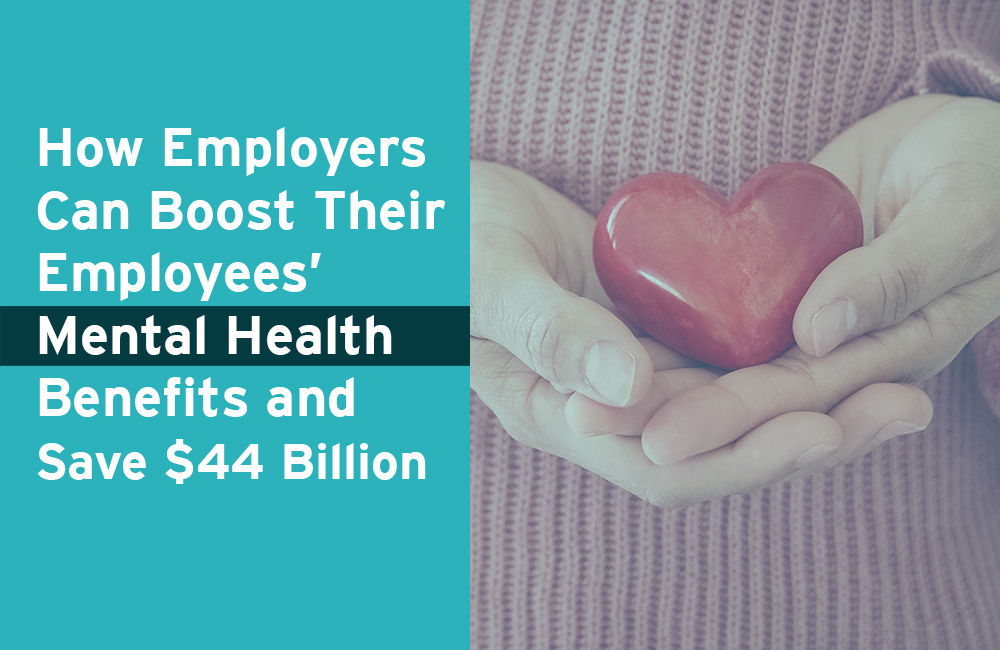
How Employers Can Boost Their Employee Mental Health Benefits and Save $44 Billion
[et_pb_section fb_built=”1″ admin_label=”section” _builder_version=”3.22″ global_colors_info=”{}”][et_pb_row admin_label=”row” _builder_version=”3.25″ background_size=”initial” background_position=”top_left” background_repeat=”repeat” global_colors_info=”{}”][et_pb_column type=”4_4″ _builder_version=”3.25″ custom_padding=”|||” global_colors_info=”{}” custom_padding__hover=”|||”][et_pb_text admin_label=”Text” _builder_version=”3.27.4″ background_size=”initial” background_position=”top_left” background_repeat=”repeat” global_colors_info=”{}”]
Boosting your employee mental health benefits this holiday season may be a good idea; although it’s the time of year for Holiday cheer, there’s a good chance that some of your employees are feeling stressed out right now. One in five people. External Link. Opens in new window. experience a mental health issue each year, and if untreated, it can cause serious health issues down the line.
Patients with depression have a 40% higher risk for cardiovascular disease, while 32% develop a substance abuse issue, and even worse, suicide remains the second leading cause of death for young adults.
It should be noted that these are typical, pre-pandemic statistics; this was a problem before COVID-19, but as the pandemic carries on, so too are worsening mental health issues. External Link. Opens in new window..
Unfortunately, communities of color disproportionately experience mental health issues at a much higher rate, and despite reporting higher levels of depression, anxiety, and substance abuse. External Link. Opens in new window., Black, Hispanic, and Latino adults have historically faced barriers when it comes to access for mental health care. Lastly, and perhaps most stunningly, nearly half of all lesbian, gay, and bisexual individuals report experiencing a mental health issue – the most of any demographical group. External Link. Opens in new window..
Employers don’t just have a social or moral obligation to help improve employee mental health benefits, either. When it’s all said and done, depression alone costs employers $44 billion annually.
The key to making improvements in employee mental health is to combine affordable, effective, and individualized care options and improving access/removing barriers to them.
Lead by Example
Per the Anxiety and Depression Association of America. External Link. Opens in new window., 18% of the total population suffers from depression, and despite being a highly treatable illness, only about a third are being treated for it. And despite differences in race, gender, identity, and genetic predispositions, most folks share one thing in common: they have an employer. Therefore, this gap provides employers and health care providers the opportunity to service the mental health needs of 25 million Americans.
But simply offering an EAP resource and calling it a day won’t cut it. Employers need to lead by example. Long hours, everchanging shifts, safety hazards, and hostile work environments can add unnecessary stress to individuals and exacerbate anxiety and depression within the workforce. By tackling pre-existing psychosocial hazards. External Link. Opens in new window. first, employers can practice what they preach and show employees they care about improving their employees’ mental health and wellbeing on the job.
Audit Your Employee Mental Health Benefits
Additionally, employers should audit their networks and health benefits to ensure their employees have access to mental health resources. And if they’re serious about their employees utilizing those resources, affordability is just as important; ensure your health plan offers broad access to in-network mental health providers. (We added more than 350 mental health providers to our Comprehensive Network in 2020 alone.) Removing or reducing co-pays for employee mental health counseling and certain prescription drugs also greatly improves mental health care access.
Roughly half of counties across the U.S. have no psychiatrists, so it’s necessary to ensure your health plan offers telehealth services. Telehealth eliminates multiple barriers to mental health treatment, like transportation and costs, while offering comparable results. External Link. Opens in new window..
The federal government greatly expanded telehealth access for Medicare and Medicaid patients during the COVID-19 pandemic under Waiver 1135. External Link. Opens in new window., and KFF found. External Link. Opens in new window. that people of color and low-income earners benefitted most from the improved access.
Employers are taking notice and investing in telehealth benefits; nearly 95%. External Link. Opens in new window. of employers offer some form of telemedicine, while only 4% said telemedicine would be unimportant in the future.
Stop the Stigma
One of the biggest barriers employees face in getting help is the stigma associated with mental health illness. Those suffering from depression, anxiety, or substance abuse may conceal their symptoms or be completely unaware they have an illness due to lack of education and resources.
One way employers can create trust within their workforce is by implementing practical programs that are designed reduce that stigma, like Stamp Out Stigma. External Link. Opens in new window. and Make It OK. External Link. Opens in new window..
Empowering Employees Through Education
If reducing stigma is the first step towards improving employee mental health, the next is by offering education, resources, and work programs that teach employees to recognize and address symptoms. (This one. External Link. Opens in new window. teaches employees to become mental health advocates for one another.)
Employee mental health requires compassion and understanding, and education goes a long way towards making employees feel more comfortable discussing these issues with their doctor. Employers can “normalize” these issues by explaining the facts of how many people are affected by mental health issues, the risks of untreated mental illness, and most importantly, the benefits of mental health treatment.
Posting informational resources (like these posters. External Link. Opens in new window.) on bulletin boards, the company intranet, and in the lunchroom serve as good reminders for employees to check in with themselves more often. Flyers and are not a catch-all, but they do help staff recognize the symptoms of mental illness, how to cope with them, and how and where to request additional resources. Plus, they show staff that employee mental health is a topic their employer understands and cares about.
Depending on your patient population, you should also ensure these resources are bilingual or made available in other languages as necessary.
Frequency is Key
Sharing educational resources that support good employee mental health is necessary and needs to be done on an ongoing basis. For reasons outlined above, employees may be apprehensive to seek help at first, so regularly reminding them about the severity of unchecked stress and how to talk to their doctor about their mental health is critical.
Increasing the frequency and channels in which you communicate those messages tells them you’re making employee mental health and wellbeing a priority. Employers should consider using meetings (open enrollment, town halls, lunch-and-learns, etc.) to talk about and share mental health resources.
Confidentiality is of Chief Concern
Lastly, and perhaps most importantly, confidentiality is key. Employees need to be assured that by seeking treatment – especially for something like substance abuse – that their information will be private and there won’t be backlash by their employer. Likewise, if employees are worried about what their coworkers will think of them for seeking help, they are unlikely to take the first steps towards intervention.
Creating a workplace culture where staff feel safe to seek help and ask questions – especially when it comes to mental health – will help employees put their best foot first in taking care of employee mental health.
Other employer resources:
Workplace programs:
- Stamp Out Stigma. External Link. Opens in new window.
- Make It OK. External Link. Opens in new window.
- Mental Health First Aid. External Link. Opens in new window.
Educational Resources:
- American Psychiatric Association Foundation Center for Workplace Mental Health
- Mental Health America: Depression in the Workplace. External Link. Opens in new window.
- National Alliance: Integrating Mental Health Services and Primary Care. External Link. Opens in new window. – Harvard Business Review: How to Manage an Employee with Depression. External Link. Opens in new window.
[/et_pb_text][/et_pb_column][/et_pb_row][/et_pb_section]








